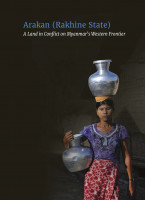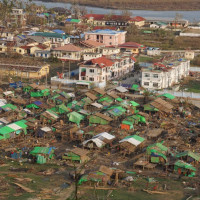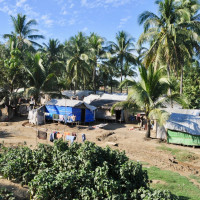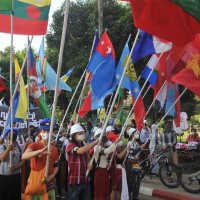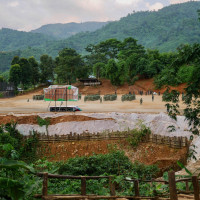A New Dimension to Armed Conflicts in Arakan? Core Tactics of Myanmar Military’s ‘Divide and Contain’ Strategy
Regions
A Myanmar Commentary by Naing Lin
As conflict and suffering continue, the military State Administration Council is trying to use the tactics of ‘divide and rule’ to undermine countrywide resistance. But analysing experiences in Rakhine State, Naing Lin explains in this commentary why such stratagems are unlikely to work, whether splitting opposition movements or instigating inter-community conflict. Rather, the failures of the past are being repeated, while the United League of Arakan continues to build influence across the territory.
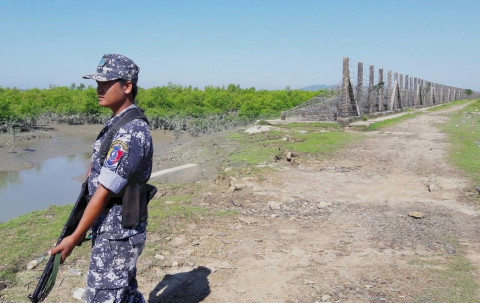
Border News Agency
Myanmar is currently in a state of political and economic emergency. More than two and half years after the 2021 coup, the military government (officially known as the State Administration Council [SAC]) has been unable to restore peace and stability in the country amidst a continuing – and still rising – resistance movement in support of pro-federal democracy. The situation is quite different to the national breakdown that followed the previous military coup in September 1988. After passing through ten years of quasi-democratic liberalisation (2011-2020), many aspects of Myanmar politics and society have changed. The degree of change may vary in different parts of the country. But important dynamics in supporting change include exposure to democratic procedures and practices, enlargement of space by civil society actors, the spread of digital and communication technology, urbanisation and industrialization, and the improvement in material well-being in non-conflict areas of the country during ceasefires in the 2011-20 period.
All these phenomena helped prepare the ground for a more open and pluralistic future. Critically, they also combined with the emergence of the new ‘Generation Z’ of young people who are more politically aware than their ‘88 generation’ predecessors. As a result, popular rejection of the SAC coup was immediate, bringing about a dramatically new paradigm shift in socio-political mobilization across the country. The impact also resonated in ethnic politics, with the existing movements – including armed groups, political parties and civil society organisations – deciding to receive and cooperate with new formations among the ethnic Bamar (Burman) majority and newly-mobilised youth in the towns. Within months, the social and political landscape was transformed, symbolised by the creation of the pro-democracy National Unity Government (NUG) as a rival to the military SAC. For this reason, the phenomenon of the post-coup resistance can be better described as ‘revolution’ rather than ‘rebellion’ since the former has broader socio-political characteristics instead of simply seeking to change the government or regime.
After decades in power, though, the Myanmar military has become a hard-dying entity as a self-serving institution. The ideology, identity and interests of the organisation, known as the Tatmadaw or Sit-Tat, are highly integrated into what leaders call ‘national politics’ under the 2008 Constitution. Since the first military coup in 1962, the ruling generals have come to regard themselves as the sole liberators and guardians of the country, and they have been building up institutional capacity and dominance in many aspects of national life – including political processes, economic resources and social values – which are highly autonomous from other sectors of society. In consequence, the Myanmar military has become an increasingly isolated institution separated from the people, behaving more like a prerogative ‘state within a state’ or, equally divisive, ‘an army with a country’ rather than ‘a country with an army’.
To try and maintain this dominance, the Myanmar military has always identified itself as the permanent ‘protector’ and ‘promoter’ of the ‘(Burmese) race and (Buddhist) religion’. Over the years, this claim has drawn some forms of recognition and legitimacy from Myanmar nationalists and the broader population among the orthodox Buddhist Sangha and worshipper community. This protector role has also been promoted during times of conflict with non-Bamar or non-Buddhist groups, especially Chin, Kachin, Karen, Karenni and Rohingya. Since the coup, however, the very foundations of these claims to moral and nationalistic legitimacy have been wavering due to the escalation of new dimensions in conflict involving Bamar Buddhists in central and lowland areas of the country. This has witnessed the burning of villages and Buddhist temples by the Myanmar military as well as the killing of Buddhist monks and Bamar civilians, amplifying grievance across all communities and sectors of society.
As repression and suffering continue, the conclusions are clear. Since the coup, the key political trends in national politics have revealed the true colours of the Myanmar armed forces as an institution that only protects and promotes the interests and power of the military itself – and any means necessary will be employed to achieve this. In political science definitions, this is called the ‘patrimonialization of the state’ in which the agent itself becomes the sole principle for its own interests at the expense of the broader public ones. As a result, the tactics used by the Myanmar military to remain in power have become a central crisis facing the country, and once again they are being deployed to hold back peace and national reconciliation which the people have long desired.
Myanmar Military’s Nationwide Art of Ruling
There has long been an unhelpful paradigm in Myanmar politics. Although the majority of pro-democracy groups among the Bamar-majority population and nationality movements among the non-Bamar peoples have generally regarded the Myanmar military as ‘the common enemy’, in reality effective collaboration and solidarity among these groups has often faltered in the past, and this is still proving a difficult task in terms of momentum, vitality and persistence today. Compounding this weakness, existing internal divisions or factions among forces opposed to the regime have historically paved the way for leaders of the Myanmar military to use a common strategy known as ‘divide and rule’ as a means to dissipate opposition. With some post-coup refinements, such stratagems are very much part of the political landscape today.
In essence, faced with countrywide resistance, the primary focus of the SAC is not so much ‘divide and rule’ as ‘divide and contain’, and the tactics applied to implement this strategy are based on different factors in the different states and regions. These stratagems historically include manipulation by political and economic incentives, the promotion of tension between ethnic and religious identities, the capturing and creation of divisions among nationality leaders, and the launch of military operations or, conversely, declaration of ceasefires in the different conflict zones.
Deepening these schisms, numerous instances of division or sub-division have been exploited in recent decades within a particular ethnic state or nationality movement in such territories as Kachin, Karen, Karenni (Kayah) and Shan states where there may be more than one ethnic armed organisation. In such cases, the Myanmar military seeks to cause clashes or splits in local communities by directly or indirectly supporting select groups from behind the scenes. This may be attempted by the agreement of ceasefires with a preferred nationality force or by creating state-sponsored people’s militia and Border Guard Forces, some of which are former ceasefire groups that have come under Tatmadaw control. After decades of such machinations, Myanmar has one of the most complex conflict landscapes in the world, and many communities have never known peace.
Following the 2021 coup, such tactics have brought political and security advantages for the regime leadership, as well as prerogatives for military rule, beyond the economic and material reasons behind the SAC takeover. Militarily, the junta leadership is attempting to use groups that they sponsor in order to try and deter expansion by more powerful ethnic movements, such as the Kachin Independence Organisation and Karen National Union (KNU), and to provide extra logistical support in their attacks against the NUG and other opposition groups. Economically, the Myanmar military is continuing to conduct business enterprise through, or in partnership with, favoured allies or cronies in the exploitation of natural resources in the ethnic conflict zones where valuable minerals are located. And politically, the SAC leadership is trying to use divisions among armed groups in order to reject representation by opposition movements in national politics or, equally manipulative, take the opportunity to act as a ‘third-party neutral arbitrator’ when conflicts arise. In this way, influential ethnic organisations can find it difficult to present themselves as the legitimate actors for their respective states and territories even where they enjoy popular support and maintain widespread administrative control.
Clearly, the struggle for political change has reached to a critical stage. But recently a different scenario has emerged in Arakan (Rakhine State) in the west of Myanmar with the rapid growth of the United League of Arakan/Arakan Army (ULA/AA). This, in turn, raises new questions about developments on the ground that may yet come to determine the country’s future. As experiences in Arakan show, the struggle for democracy and regime change is following on more than one path. The following part of this analysis therefore seeks to explore latest events and outcomes in Rakhine State, one of the most under-reported but strategic parts of the country.
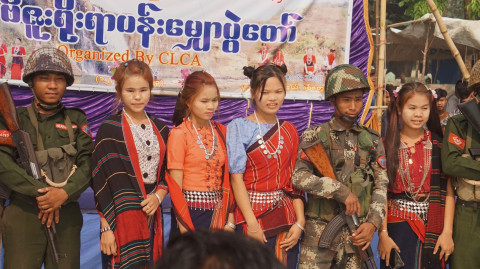
Border News Agency
Junta’s Governance in Post-Coup Arakan
The outbreak of armed violence between the Myanmar military and Arakan Army during 2018-20 and the solidarity stance taken by the National League for Democracy (NLD) in government with the Tatmadaw against the ULA/AA did much to shape political responses in Rakhine State after the coup. Already the ethno-political landscape had been changing with the announcement of a de facto ceasefire between the Tatmadaw and ULA/AA in November 2020, shortly after the general election won by the NLD and three months before the military coup. Both the Myanmar military and NLD were distrusted in many communities, including the smaller Chin, Daingnet, Kaman and Mro ethnic groups, a perception amplified by the 2017 flight of over 700,000 Rohingya refugees into Bangladesh in the face of Tatmadaw attacks. In consequence, the post-coup message of the ULA leadership not to encourage public protests in Rakhine State and the Civil Disobedience Movement active in other parts of the country brought about a unique political landscape that was different to other states and regions following the SAC takeover.1
Initially, the regime appeared happy to try and take advantage of the ULA/AA ceasefire. Key political figures were recruited from Rakhine political parties to work with the SAC, notably Daw Aye Nu Sein of the mainstream Arakan National Party (ANP) who was appointed to the military council, while Dr. Aye Maung, leader of the smaller Arakan Front Party (AFP), was publicly pardoned.2 At the same time, the junta removed the ULA/AA from its list of ‘terrorist organisations’ in March 2021, though still keeping the movement on the register of ‘unlawful associations’.3 For a time, political trends in Arakan seemed quite different to other parts of the country.
On the ground, however, the situation was not static. To their concern, the SAC authorities witnessed a rapid build-up by the ULA in local and judicial administration, reflected in expansion southwards into Kyaukphyu and Taunggok (Toungup) townships as well as northwards in Maungdaw township where clashes broke out. As result, there were many incidents in which junta soldiers attempted to raid the ULA’s administrative and judiciary offices, especially in the south of the state.4 In reality, despite the ceasefire, the SAC never wanted to accept ULA/AA control or influence nor the movement’s emergence as the dominant political actor in the state.
In response, the junta authorities initiated various tactics to try and contain the activities of ULA/AA supporters. The first method was an attempt to invoke a ‘north-south regional cleavage’ among the Rakhine-majority population. Traditionally, most Rakhine nationalist movements and key leaders have come from the north of the state. In contrast, a large proportion of the population in southern townships, such as Taunggok, Thandwe and Gwa, have followed the mainstream party of the NLD rather than Rakhine parties in support of national change. To fuel this difference, the first junta-appointed chief minister for Rakhine State, Dr Aung Kyaw Min, was a Taunggok native, appealing to the sentiments of local people in containing the ULA’s southern expansion.
Such perceptions and stratagems by the Myanmar military are also not new. The wife of the junta leader, Snr-Gen. Min Aung Hlaing, is an ethnic Rakhine from Thandwe in the south, and in an interview shortly before the coup he claimed to have many relatives in southern Rakhine State but said that Rakhines in the north are a ‘bit bad’. More ominously, the magazine Myanmar Now reported in August 2022 that township-level officers under the SAC are attempting to form local militia forces in seven-member teams for every ward and village in Kyaukphyu township in the heart of the state.5 In other parts of the country, the establishment of new militia by the Myanmar military – variously known as ‘pyithusit’ and ‘pyusawhti’ – can be seen as a response to the formation of People’s Defense Forces (PDFs) in support of the NUG. But in Rakhine State, where the NUG and PDFs have no presence, these tactics are clearly a shot against the ULA/AA.
As of today, the SAC’s attempt to create a north-south division seems to have ended in vain without effective implementation. In reality, even if local differences appear, the tactic can be regarded as likely to fail because of important changes in Rakhine political consciousness during the past decade. As in other ethnic states and regions, the regime authorities do not understand the goals and aspirations of the local people.
Three factors stand out. First, the outbreak and spread of armed conflict in northern Arakan alarmed many Rakhine people living in the south. Subsequently, solidarity and ethno-political experiences were enhanced by the grave human rights violations and war crimes committed by the Myanmar military against their Rakhine brothers and sisters. The failures of the NLD in office (2016-20) to address these issues only added to long-standing disillusion with central governments that are dominated by the ethnic Bamar-majority. With voting cancelled by the authorities in the 2020 general election in the north of the state, the rise in Rakhine consciousness was highlighted by the election victory of the ANP in the two NLD stronghold constituencies of Taunggok and Manaung townships in the south. Indeed, with the exception of Gwa in the far south, the NLD’s only election victory in Rakhine State in 2020 was in Thandwe constituency, but this only came about as a result of a voting split between the three leading Arakan parties: the ANP, AFP and Arakan League for Democracy.6
Since this setback, the NLD appears to have disappeared from the political scene altogether in the wake of the coup, with the population in southern Rakhine State, like those in the north, beginning to regard the ULA as a viable alternative to junta rule. This change in perspectives has been further hastened because, unlike most revolutionary movements in the past, the current core leadership of the ULA/AA is represented by many southern natives, such as Dr Nyo Twan Aung, deputy chief of the ULA/AA.
In addition, due to the parlous economic situation, internal migration has come into the social and political equations. As the second poorest state in the country, communities in northern Rakhine State have faced more livelihood challenges than in the south. This has caused many people to move into Taunggok and Thandwe townships where there are better business and job opportunities, especially in fishing and at the tourist centre of Ngapali Beach, along with closer trade and economic relations with other parts of the country. As a result, northern Rakhine populations have appeared in southern townships over the past two decades, further adding to nationalist sentiments and support for the ULA, especially in rural areas.
This leads to the second tactic that the junta authorities have attempted to employ in their ‘divide and contain’ strategy: the instigation of ‘internal armed factions’ among the Rakhine community. Currently, there are three Rakhine ethnic armed organisations: the ULA/AA and older, but largely legacy, movements of the Arakan National Council/Arakan Army (ANC/AA) and Arakan Liberation Party/Arakan Liberation Army (ALP/ALA). In every respect, the ULA/AA is the strongest and most popular organisation, and it currently controls large parts of Rakhine State in parallel to the junta administration as well as adjoining territories in Chin State that were historically part of Arakan. The other two groups, the ANC/AA and ALP/ALA, are small and generally little-known today, with almost no military presence in Rakhine State. Despite such marginalisation, it is the ALP which is presented in the state media as politically more active and important, having close relations with Myanmar military leaders after signing the Nationwide Ceasefire Agreement (NCA) in October 2015.
Appearances, however, can be deceptive and, following the coup, the NCA is essentially defunct. Rather, the ALP/ALA has recently experienced a series of internal splits in three military zones where supporters claim to be active: the ‘northern’ border region with India, ‘central’ Sittwe township in Rakhine State, and an ‘eastern’ base in KNU-controlled territory in the borders with Thailand where a training camp is located. A ‘first’ ALP split occurred in January 2022 between rival factions led by Khaing Ray Khaing (party chair) and Saw Mra Razar Linn against Khaing Soe Naing Aung (Vice-General Secretary-2).7 Then a ‘second’ split took place in March 2023 within the faction led by Khaing Ray Khaing and Saw Mra Razar Linn.8 And the schisms in the ALP became explicit on 1 September 2023 when the party’s veteran chair, Khaing Ray Khaing who heads the ‘northern’ and ‘eastern’ factions, released a statement that they no longer recognize the NCA, claiming to be ready to collaborate with other anti-junta forces in Arakan.9
In response to these developments, it is the faction led by the self-appointed leader Saw Mra Razar Linn, based in urban areas of Sittwe, which is being protected and recognised by the SAC. Quite how these schisms will impact on broader Arakan politics are uncertain, but the initial consequences appear divisive. Under current dynamics, relations between the ULA leadership and Razar Linn’s ALP-Sittwe block have been deteriorating with speculation growing that this breakaway group will be changed into a border guard militia under Tatmadaw command.10 In recent months, there have been frequent allegations of ALP members wearing uniforms of the Myanmar military bearing party emblems as well as reports of collaborative security and surveillance activities with regime soldiers who have been arresting and torturing civilians suspected of being ULA/AA cadres in Sittwe. In response, arrests have been reported of ALP members by the AA as well as accusations of the assassination of top ALP figures.
For the moment, there appear to be limits as to how far this division will spread. Unlike the success of the Myanmar military in fomenting splits by supporting rival forces and militia in Kachin, Karen and Shan States, the remnant movement of the ALP has become a largely unpopular and non-cohesive actor over the years. Leaders have almost no local audience which might allow them to become a feasible military and political element in the junta’s ‘divide and contain’ strategy. Nevertheless such internal tensions are a distractive problem for the Arakan movement. First, the SAC is seeking to provoke division among armed opposition groups by offering a choice between punishment and rewards. And second, the SAC is hoping to promote alternative voices to undermine the ULA’s power projection in the Rakhine State capital Sittwe where the Razar Linn faction is based.
Finally, the third tactic employed by the SAC authorities to undermine Arakan unity is the instigation of tensions over questions of ‘religious and racial’ identity. This is especially contentious in the case of the Rakhine and Rohingya communities. The issues are complex, and there are many factors that can interplay with some very non-linear interactions between the different actors. But in the aftermath of communal violence in 2012 and the mass flight of Rohingya refugees during the Tatmadaw’s 2017 operations, this remains one of the most sensitive issues in the country and one that is under close international scrutiny.
A key issue is that of institutional representation. Although the ULA/AA can be regarded as the leading movement broadly representing the political will of the Rakhine population, it is very hard to say which particular organisation or leadership can claim a similar role for Rohingya communities. Reflecting this dilemma, there are at least three Rohingya populations in present demographic terms: inside Rakhine State, in refugee camps in Bangladesh, and diaspora elements in different countries abroad. Indeed, with political activities in Rakhine State largely repressed, it is the diaspora leaders and activists who generally represent the Rohingya cause in international advocacy, and it is from these voices that the Rohingya plight is often best known.
The same challenges in representation exist among Rohingya armed groups which have fluid identities and organisation, operating mostly in the so called ‘no man’s land’ or ‘zero-line zone’ along the Bangladesh border. These movements include the infamous Arakan Rohingya Salvation Army (ARSA) which became widely reported during the 2017-2018 attacks by the Myanmar military on Rohingya communities; the former Rohingya Solidarity Organisation (RSO) which became the best-known force following the ending of armed struggle by the Arakan Rohingya Islamist Front; and, after the 2021 coup, RSO elements are also reported to have emerged as new forces with one group, known as the Arakan Rohingya Army (ARA), led by a reported drug dealer, Abdullah Kane. All these groups claim to represent the ‘Rohingya cause’ and oppose the Myanmar military.
There is, however, little unity or shared ideology between these groups. Rather, with the revival of armed opposition, there have been a number of clashes and reciprocal assassinations between the RSO, which is preferred by the Bangladesh security forces, and the ARSA over the issue of control of ‘no man’s land’ and influence in the refugee camps where ARSA is widely feared. Violent incidents have been reported in a power struggle over the past year, with the RSO achieving supremacy and ARSA retreating into Maungdaw and Buthidaung townships in the north of Rakhine State.
These instabilities, in turn, and the emergence of armed Rohingya groups across the Naaf River frontier are now raising questions about relationships with the ULA/AA, the dominant ethnic armed force in the India-Bangladesh borderlands, as well as with local Rakhine and other non-Bamar peoples. Over the years, there have been tensions, and sometimes clashes, with the outbreaks of violence during the previous decade not forgotten.
In the case of the ULA/AA, in an interview in January 2022 Maj-Gen. Twan Mrat Naing, the party’s chief-of-staff, remarked that the RSO appears to be politically more mature than the ARSA but that the ULA/AA has no ties with either of them. Subsequently, the AA did experience some minor armed clashes with both groups: with the RSO in northern Maungdaw township in October 2022, and with the ARSA in southern Buthidaung in July 2023.11 But, in general, such incidents were considered to be localised and without the capacity to spread.
More recently, observers on the ground are reporting the spectre of more troubling developments, instigated by the rivalries between Rohingya groups and the involvement of the SAC authorities behind the scenes. During the past three weeks, two Arakan-based media agencies – the Border News Agency and Western News – have claimed that both the ARSA and ARA are being sponsored and armed by the Myanmar military in their efforts to expand into northern Rakhine State.12 The ARA is also accused by local sources of being sheltered by Myanmar border guard police with which it is cooperating in drug-trafficking.13 Complicating the picture, ARSA supporters have reportedly split into four factions, and the one that clashed with the AA in Buthidaung township in July is not led by the movement’s founding leader Ataullah abu Ammar Jununi but another, and reportedly stronger, ARSA group.14
Presently, many aspects of the situation remain unclear. But, as in other parts of the country, the reasons for the Myanmar military to foster division and back new Rohingya armed groups appear in plain sight: to destabilize the area and threaten the security of the local community while burdening the ULA/AA administration.15 As critics point out, the Myanmar military has had no armed clashes with either of these Rohingya groups during recent developments – the ARSA splinter or ARA group – although their activities have taken place in areas close to Tatmadaw bases and locations. Rather, following the clashes between the ARSA and AA in July, the SAC used the opportunity to move military reinforcements into Buthidaung township under cover of these incidents.
Local communities are now very worried about what may follow next. To date, the SAC authorities have not officially said anything about these events. But there are three conspiracy reasons to believe why they are involved. The first is that, since the ULA/AA has supported arms and training to a number of resistance groups since the coup, the SAC leadership might consider providing weaponry to Rohingya groups as a legitimate response to the ULA/AA actions. Secondly, instability and clashes between Rohingya groups and the ULA/AA might provide an excuse for the SAC to portray the conflict to the International Court of Justice and International Criminal Court as an obstacle to refugee repatriation and resolution of the Rohingya crisis. And the third, and most likely, reason is that the Myanmar military is providing arms to Rohingya groups in order to hinder the ULA/AA’s increasing dominance in Maungdaw and Buthidaung townships, to trigger tensions between Rakhine and Rohingya communities, and to weaken social cohesion efforts by the ULA/AA. In short, all three reasons are in line with well-documented tactics by the Myanmar military in other parts of the country.
The question, then, is what their impact will be in Arakan.
Will the Junta’s Tactics be Effective?
Despite the stratagems of the Myanmar military, there are still critical questions to be asked as to what extent they are achievable and what the consequences will be. The first and second reasons for these manipulations – tit-for-tat arms supplies and international perspectives – are less consequential issues that can be divisive only if external actors, whether in the country or abroad, make them so. However it is the third scenario – fostering inter-communal conflict – that is politically more worrying and can produce damaging consequences in the long term.
The ramifications of these events will depend on a number of factors in the social and political landscape. In the case of community division, the Rohingya groups backed by the SAC will not just pose barriers to ULA/AA dominance in the Bangladesh borders but also threaten community security for Rohingya, non-Rohingya and non-Muslim groups alike. However, in contrast to outbreaks of violence in the recent past, there are reasons to believe that clashes between the AA and Rohingya armed groups will not automatically be translated into conflict between Rakhine and Rohingya communities.
There are two main reasons to support this. First, the nature of Rakhine ‘ethno-nationalism’ has been changing. Traditionally, there were both dark and bright sides to Rakhine nationalism. The dark or negative side includes hatred and aggression toward ethnic Bamar and Rohingya communities, reflected in discrimination against non-Rakhine minorities. The bright or positive side, by contrast, reflects the political motivation and consciousness of the Rakhine population in demanding and struggling for the right to self-determination and sovereignty for all the peoples in Arakan. Such sentiments go back to the 1784 fall of Mrauk-U and have continued through the decades of colonialism and socio-economic deprivation which followed. Although there are still many forces in Rakhine politics on the dark side, the positive side has gained more momentum in recent years due to the rise of the ULA/AA and efforts by various non-state actors in inter-community healing. This, in turn, has paved the way for greater social cohesion and reconciliation among local peoples. Lessons, it is trusted, have been learned from the traumas of the past.
The second reason to believe the provocation of inter-communal strife will not work relates to the role of the Rohingya armed groups and perceptions by the Rohingya community towards them. For the moment, neither of the Rohingya armed groups being encouraged or supported by the Myanmar military are regarded as legitimate actors in their own communities, and recent efforts at social cohesion by the ULA and other non-governmental actors have brought positive improvements in constructive relations in northern Rakhine State. As evidence of this, there are many ULA members and supporters from the Rohingya community in Arakan, and the situation is very different from times in the past when there were inter-communal explosions.
There is, though, no room for complacency. There are no clear black-and-white determinators of what might happen next and, in the final analysis, the impact on community relations may well depend on how Rohingya leaders and community activists interpret any escalation in armed clashes between the ULA/AA and Rohingya groups. The situation is dynamic and by no means certain on the ground. While the SAC shows signs of initiating a refugee repatriation due to pressure from China, the majority of the Rohingya refugees – as well as community activists and international supporters – see it as challenging and premature to go back in such a fragile landscape. The de facto ceasefire between the SAC and the ULA/AA is also in a loose state, with the two parties deeply suspicious of one another. And, equally important, the emergence of Rohingya armed groups backed by the Myanmar military is widely regarded as a potential cause – not solution – to conflicts on the ground if such militia gain local traction.
In summary, the tragic tone of the political drama in Arakan continues with echoes of the past but with a changing cast of actors in different characters and new roles. In the meantime, the Myanmar military is not seeking reconciliation or political reform but continuing its long-term tactics of ‘divide and contain’ in its bid to remain in control of government. The SAC, however, is failing. As in other parts of the country, resistance continues on multiple levels, and the tactics of the Myanmar military are only exacerbating the sufferings of the people.
Naing Lin is a freelance political analyst and researcher writing about peace, democracy and community relations in Rakhine State, Myanmar.
